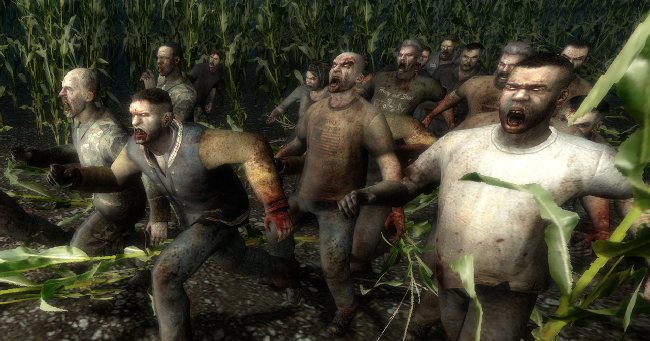Trending
Opinion: How will Project 2025 impact game developers?
The Heritage Foundation's manifesto for the possible next administration could do great harm to many, including large portions of the game development community.

Featured Blog | This community-written post highlights the best of what the game industry has to offer. Read more like it on the Game Developer Blogs or learn how to Submit Your Own Blog Post
Can systems like Left 4 Dead's AI Director be put to use in other games?

This article originally appeared on dashjump.com.

Left 4 Dead

More...
So why, in the age of endless zombie games, did this particular zombie game do so well? And more interestingly, why has Valve not released any new installments since 2010, after rapidly developing a sequel and multiple DLC packs?An obvious answer to the first question is the sense of authentic cooperation created by the game’s mechanics, afforded in no small part by the “Director,” the much-admired AI system that generates random enemy encounters; prompts changes in the environment; and adjusts the placement of items players find, all based on a calculated ‘stress level’ for each player. For the first time in a game, an AI entity could modify multiple elements of the level on the fly for a tailored experience every time. It’s perfect for zombie games, right?
Wrong. It’s perfect for EVERYTHING.
“We set out to create a first-person four-player game in which the action changes each time it’s played. We wanted to use procedural narrative to simulate stories because, in a multiplayer environment like this, we felt a more linear, scripted approach would not deliver in the same way.” –Gabe Newell
There’s a reason Gabe calls what the AI Director does procedural narrative, and not procedural zombie spawning. All throughout the piece he wrote for Edge as part of a PR push for L4D, he hints broadly about the implications for cooperative games of all types, as well as single-player games. The promise had already been recognized internally at Valve long before the game debuted; the rest of the industry just never caught on.
But back to L4D’s use of it in particular. One thing to note is that the AI Director approach is not dynamic difficulty. Dynamic difficulty has been around for a while, and is largely based around the idea of the system making minute adjustments to existing values in order to raise or lower the game’s difficulty. For example, In Max Payne, the system would make tweaks to enemy health and the degree of aim assistance based on how well/poorly you were dominating/getting wrecked. The end result was a tighter game that never felt too easy or too hard; but all the same, each playthrough was identical.
"This is what makes procedural narrative more of a story-telling device than, say, a simple difficulty mechanism." -Gabe Newell
Apparently, a similar tact was used in Half-Life 2: Episode 1 and 2, where you would receive different items from crates depending on your health status at the time you smashed it. Again, more than anything else, this kind of adjustment on the fly would help level the playing field without altering the experience too much – the core experience is still the same. This is why the AI Director is different – using player activity data, it sculpts a dramatically different experience that fits perfectly with what players are capable of and that engages them on a primal level, since L4D’s focus is a survival/action/horror hybrid.

Max Payne
Max Payne's dynamic difficulty system helped keep battles tense, but they were always the same.But if you remove the zombies, health packs and clichéd apocalyptic scenarios, you’d be left with a core truth of what this system affords: instant eviction from the comfort zone. While the comfort zone is a nice place to hang out in, in life as well as in games, the returns diminish quickly since you’re essentially in a suspended state in which no learning takes place.
This is why games that, on paper, should be exciting and thrilling prove to be boring despite the number of explosions, particle effects and screaming marines that fill the screen. Disruption of the expected, when you’re pushed into a new experience and enter the discomfort zone, is the thing ultimately responsible for you learning more about the system, your recourses and your capabilities, and is what makes you better at playing the game. While it’s stressful at first, this dynamic proves to be more pleasurable in the long run.
“Going forward, we’re definitely going to use some of the things that we’ve learned – what worked and what didn’t work – with Left 4 Dead not only in multi-player but also in our single player games in the future.” –Gabe Newell
So why aren’t more games using this principle? After all, it has been almost five years since Valve debuted the Director. The only reasons I can think of are the prohibitive complexity of creating such a system, and simple laziness. Perhaps this system really is only suited for horror games, you say? How could similar systems even be implemented in other games? Let’s take a look!
Racing. Create courses with dynamic events, similar to Split/Second – though instead of having events be scripted into the tracks, enable them on the fly to correspond with the player’s performance.
Shooter. Think of a wide-open shooter with a single-player component, like Halo or Battlefield. Instead of scripted enemy waves attacking from the same direction every time, why not have them drop in via parachute or dropship, launch assaults in vehicles from over the horizon, or spawn mini-bosses where you’d normally expect a battalion?

Split/Second
Split/Second's track destruction is scripted. Imagine if it was dynamic, based on the player's stress level.RPG. In a story-driven RPG that focuses on dialog, should you grow closer to certain NPCs, why not have them drop plot bombshells that threaten your relationship thus far – and better yet, do it in the middle of a climactic battle?
Sandbox. In a Deus Ex-style sandbox game, why not have Director-triggered EMP events temporarily cut off access to certain augmentations, forcing you to adapt to different combinations of powers you wouldn’t normally combine? Remember, the Director would know which combinations you’ve been using regularly.
Arcade. In a Super Hexagon-style reflex/puzzle game, why not sculpt purposeful obstacles for the player that build upon what they’ve just overcome, instead of simply swapping in components from a pool of prefab barriers?
Beat ‘em up. In a God of War-style melee brawler, why not have enemies switch up their attack patterns and weaknesses depending on the player’s proficiency at dispatching certain enemy types?
Of course, there’s a fine line between pushing the player into the discomfort zone and unfairly screwing with the player as a way to extend replay value. In any of the above examples, the key to creating an authentic ‘discomfort zone’ dynamic is to make sure there are plenty of options available to the player under the new circumstances.
If the goal is to encourage improvisation through immediate, unexpected constraints, this would fail if the player did not have adequate options for dealing with the new problem that’s suddenly been foisted upon them.
"One of the theories of fun we use is that the more ways in which the game is recognizing and responding to player choices, the more fun it seems." -Gabe Newell
The secret sauce of L4D, the reason why it was (and continues to be) such a hit, lies in attaining a balance in such a system. It lies in how it makes players anxious for what’s next by making their moment-to-moment actions matter in a more truthful way than purely scripted sequences could.
For developers and designers alike, I challenge you to think of how similar Directors can keep your experiences varied, your players fully engaged and your replay value unlimited.
Read more about:
Featured BlogsYou May Also Like